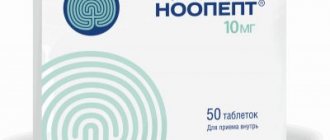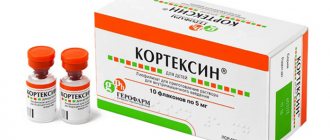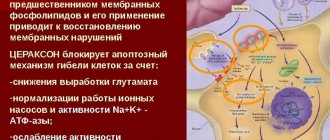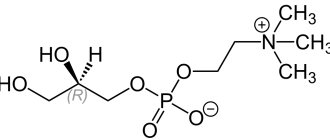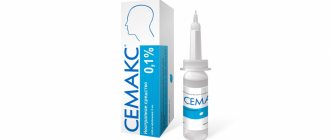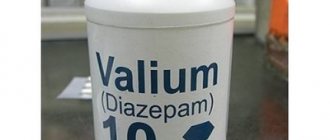pharmachologic effect
Antihypoxic, antiaggregation, neuroprotective, vasodilator, improves cerebral circulation.
Pharmacokinetics
Suction
After oral administration, it is quickly absorbed. Cmax in blood plasma is achieved 1 hour after administration. Absorption occurs mainly in the proximal gastrointestinal tract. When passing through the intestinal wall it is not metabolized. Cmax in tissues is observed 2-4 hours after oral administration. Bioavailability is 7%.
Distribution
With repeated oral doses of 5 mg and 10 mg, the kinetics are linear.
Binds to plasma proteins by 66%. Penetrates through the placental barrier.
Metabolism and excretion
Clearance of 66.7 l/h exceeds the plasma volume of the liver (50 l/h), indicating extrahepatic metabolism.
T1/2 is 4.83±1.29h. Excreted in urine and feces in a ratio of 3:2.
Pharmacodynamics
Improves brain metabolism by increasing the consumption of glucose and oxygen by brain tissue. Increases the resistance of neurons to hypoxia, enhancing the transport of glucose to the brain through the BBB; transfers the process of glucose breakdown to the more energy-efficient aerobic pathway; selectively blocks Ca2+-dependent phosphodiesterase; increases levels of AMP and cGMP in the brain. Increases the concentration of ATP and the ATP/AMP ratio in brain tissue; enhances the exchange of norepinephrine and serotonin in the brain; stimulates the ascending branch of the noradrenergic system and has an antioxidant effect.
Reduces platelet aggregation and increased blood viscosity; increases the deforming ability of red blood cells and blocks the utilization of adenosine by red blood cells; helps increase oxygen delivery by red blood cells. Strengthens the neuroprotective effect of adenosine.
Increases cerebral blood flow; reduces the resistance of cerebral vessels without significant changes in systemic circulation parameters (BP, minute volume, heart rate, peripheral vascular resistance). Not only does it not have a “stealing” effect, but it also increases blood supply, primarily in ischemic areas of the brain with low perfusion.
Reviews from doctors about Cavinton and Cavinton Fort
Kudrya N.I., neurologist, Astrakhan
Cavinton is an old and proven drug. Improves cerebral circulation processes, blood rheology, nutrition of brain tissue cells. In practice, I use the tablet form of the drug. The minimum course is 1 month. Effective for chronic cerebrovascular insufficiency and vegetative-vascular dysfunction.
The medicine should be used with caution in patients with cardiac arrhythmias.
Lee D. G., neurologist, Surgut
The drug ensures normalization of cerebral circulation and improves metabolic processes in brain tissue. Recommended for the treatment of the consequences of acute stroke, chronic cerebrovascular accident, encephalopathies of various origins, and vertebrobasilar insufficiency.
The disadvantage of the drug is its ability to provoke changes in heart rhythm, tachycardia, extrasystole, and a decrease in blood pressure. It is necessary to take these criteria into account when prescribing, especially for elderly patients.
The injection form contains sorbitol, which must be taken into account when treating patients with diabetes.
Zhikhareva O. B., psychotherapist, Vologda
Cavinton is a good, stable drug from the group of microcirculatory agents. Recommended for use in neurological practice to improve the quality of the vascular bed in the central basin of the brain. Has good value for money.
The disadvantage of the drug is that at times it can cause a feeling of dizziness and attacks of nausea. It is recommended to start taking it only as directed and under the supervision of your attending physician.
Kudryashov A.V., ENT doctor, Salekhard
Cavinton is used not only in neurology, but also in ENT practice for acute and chronic sensorineural hearing loss in both adults and children.
The disadvantage of the drug is the high price, but the advantage is the good quality of the drug.
When carrying out drug treatment, side effects and undesirable reactions may occur in the form of a feeling of dizziness and attacks of nausea; it is advisable to administer intravenously in the first half of the day; caution must be exercised during the procedure, and the patient should be monitored after administration of the medicine.
Chepurnoy M. G., pediatric surgeon, Orenburg
Cavinton is a positively proven drug. Normalizes the functioning of the blood supply system to brain tissue. It is widely used to improve brain activity.
There are a number of contraindications to the prescription, for example, elderly people may have complications after taking this drug, manifested in the form of heart rhythm disturbances.
Taking into account the indications and contraindications, the age limit for using the medicine is up to 40-45 years.
Indications for use of Cavinton forte
Neurology: to reduce the severity of neurological and mental symptoms in various forms of cerebral circulatory failure (including conditions after an ischemic stroke, the recovery stage of hemorrhagic stroke, the consequences of a stroke, transient ischemic attack, vascular dementia, vertebrobasilar insufficiency, cerebral atherosclerosis , post-traumatic and hypertensive encephalopathy).
Ophthalmology: chronic vascular diseases of the choroid and retina.
Otorhinolaryngology: for the treatment of perceptual hearing loss, Meniere's disease, idiopathic tinnitus.
To avoid complications, use strictly as prescribed by your doctor.
Similarities between the compositions of Cavinton and Cavinton Forte
Vinpocetine is the main active ingredient in both drugs. This compound has a dilating effect on the blood vessels of the brain, which leads to improved blood supply to the structures with nutrients and oxygen.
Cavinton and Cavinton Forte are used for the treatment and prevention of circulatory disorders in brain tissue.
Both forms of drugs are produced in tablet form. The following compounds are present in the composition of the drugs as additional components that play a supporting role:
- talc;
- magnesium stearate;
- silica;
- lactose monohydrate;
- corn starch.
Cavinton exhibits cerebroprotective effects. After taking the drug, a decrease in the degree of damage by amino acids is observed.
Vinpocetine improves blood circulation in the brain and increases the absorption of oxygen and glucose by the cells of the central nervous system. Preparations based on vinpocetine have a stimulating effect on the metabolism of serotonin and norepinephrine. Both drugs exhibit pronounced antioxidant and stimulating properties.
The products are recommended for use in the following conditions and pathologies:
- lack of blood circulation in brain tissue;
- dysfunction of the nervous system as part of complex therapy;
- after ischemic stroke;
- during a recovery course after a hemorrhagic stroke;
- the occurrence of post-stroke complications;
- progression of cerebral atherosclerosis;
- vascular dementia;
- transient ischemic attack;
- vertebrobasilar insufficiency;
- varicose veins;
- hypertensive or post-traumatic encephalopathy.
The drugs help with disorders of the cardiovascular system, the presence of vascular pathological processes in the organs of vision and in case of damage to the retina.
After taking Cavinton, a decrease in the degree of damage by amino acids is observed.
Both drugs are characterized by a similar list of contraindications.
The main contraindications to the use of medications are:
- severe ischemic heart disease;
- periods of gestation and breastfeeding;
- acute hemorrhagic stroke;
- the presence of hypersensitivity to the main or additional components of medications;
- children under 18 years of age;
- arrhythmia in severe form.
The following side effects may occur with drug therapy using Cavinton:
- development of tachycardia;
- a sharp drop in blood pressure;
- dyspeptic disorders;
- dry mouth;
- heartburn;
- general weakness;
- sleep disturbance;
- the appearance of dizziness and migraine;
- disorders of the cardiovascular system.
Both types of medicine are recommended to be taken after eating food with plenty of water. The selection of dosage and drug therapy regimen depends on the age, concomitant indications and physiological characteristics of the patient’s body, and is carried out by the attending physician
Use during pregnancy and children
Cavinton® Forte is contraindicated for use during pregnancy, because Vinpocetine penetrates the placental barrier. Moreover, its concentration in the placenta and in the blood of the fetus is lower than in the blood of a pregnant woman. When taken in high doses, placental bleeding and spontaneous abortion may develop, probably as a result of increased placental blood supply.
Within 1 hour, 0.25% of the administered dose of the drug is excreted in breast milk. If it is necessary to use the drug during lactation, breastfeeding should be stopped.
Side effects
Side effects associated with the use of the drug were rarely detected.
From the cardiovascular system: ECG changes (ST depression, prolongation of the QT interval); tachycardia, extrasystole (however, the presence of a causal relationship has not been proven, since in the natural population these symptoms are observed with the same frequency); lability of blood pressure, feeling of hot flashes.
From the central nervous system: sleep disturbances (insomnia, increased drowsiness), dizziness, headache, general weakness (these symptoms may be manifestations of the underlying disease).
From the digestive system: dry mouth, nausea, heartburn.
Other: allergic skin reactions, increased sweating.
Drug interactions
No interaction is observed when used simultaneously with beta-blockers (chloranolol, pindolol), clopamide, glibenclamide, digoxin, acenocoumarol and hydrochlorothiazide, imipramine.
The simultaneous use of Cavinton® Forte and methyldopa sometimes caused a slight increase in the hypotensive effect, therefore, when using this combination, regular blood pressure monitoring is required.
Despite the lack of data confirming the possibility of interaction, it is recommended to exercise caution when prescribing Cavinton Forte simultaneously with centrally acting drugs, antiarrhythmics and anticoagulants.
Cavinton forte dosage
The duration of treatment and dose are determined by the doctor.
Inside, after eating.
Typically the daily dose is 15-30 mg (5-10 mg 3 times a day). The initial daily dose is 15 mg. The maximum daily dose is 30 mg.
The therapeutic effect develops approximately a week from the start of taking the drug. It takes 3 months to achieve the full therapeutic effect.
For diseases of the kidneys and liver, no adjustment of the dosage regimen is required; the absence of accumulation allows for long courses of treatment.
What is the difference between Cavinton and Cavinton Forte?
One of the differences between the 2 types of medications is the volume of the main active compound in tablet form. Cavinton contains 5 mg of vinpocetine, and Cavinton Forte – 10 mg. The concentration of vinpocetine affects the frequency of dosing and the treatment regimen.
Another difference between the drugs is that Cavinton is produced in 2 dosage forms - in the form of tablets for oral administration and a solution for intravenous administration.
The concentrate, intended for intravenous infusion, contains, in addition to the main component, the following excipients:
- tartaric acid;
- sodium disulfite;
- injection water;
- benzyl alcohol;
- ascorbic acid;
- sorbitol.
Unlike Cavinton, the Forte form is produced only in tablets for oral administration.
Intravenous use of the drug is carried out only for patients who have problems with the functioning of the gastrointestinal tract. This method of administration allows you to avoid side effects and unwanted reactions in the patient’s body, as well as achieve a faster therapeutic effect.
The drugs have significant differences in the regimen of use.
Cavinton Forte, containing 10 mg of the active ingredient, is recommended to be taken 1-2 times a day, and the frequency of use of Cavinton is 3-4 times. At the end of the therapeutic course, the dosage is gradually reduced over 4-5 days.
The medication in the form of a solution is administered intravenously using the drip method. The daily dose when using the injection solution is 20 mg of the active compound. The rate of administration of the drug should be 80 drops per minute. An opened bottle of the drug must be used within 3 hours.
Cavinton Forte is recommended to be taken 1-2 times a day.
Price
The cost of the tablet form of Cavinton is 229 rubles. for a package containing 50 pcs., 10 ampoules for intravenous administration - 246 rubles.
Packaging containing 90 pcs. Cavinton Forte, costs 620 rubles, and the price is for 30 pcs. – 255-300 rub.
